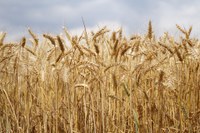Projected Profits of North Dakota Crops Vary by Region in 2019
(Click the image below to view a high-resolution image that can be downloaded)
The two highest acreage crops in North Dakota, soybeans and wheat, project limited returns to labor and management in most regions for 2019, says Andy Swenson, North Dakota State University Extension farm management specialist.
Generally, hard red spring wheat projects a return between $5 and $10 per acre. The strongest return, $22 per acre, is projected in the northeastern region, but losses of $5 to $10 per acre are projected in the northwestern, south-central and southern Red River Valley regions.
“Surprisingly, soybeans project positive returns to labor and management in all but one region, despite lower soybean prices compared to last year’s budgets,” says Swenson. “There is a projected loss of $10 per acre in the northeastern region, but for the rest of the state, returns range from $1 an acre in the southern Red River Valley to $33 per acre in the north-central region.
The third most popular crop by acreage, corn, projects losses in all regions. A loss of $5 to $10 per acre is projected for the western regions and for the southeastern, and losses between $20 and $40 per acre are projected in the other regions.
Drybeans, malting barley, lentils and chickpeas normally show relatively strong returns, but weak prices for these commodities caused 2019 profit projections to be much lower. Drybeans project a positive return to labor and management of $31 per acre in the north-central region and returns of $7 for the south-central and southeastern regions. All other regions project losses ranging from $1 to $10 per acre. Malting barley projects losses by region between $20 and $90 per acre. Projected losses for growing lentils range from $35 to $70 per acre and for large chickpeas about $10 per acre.
Projected prices for sunflowers and canola were also lower, relative to last year’s budgets. Oil sunflowers project a slight profit in the southwestern region, breakeven in the south-central region, losses of about $5 to $10 per acre in the northwest, north-central and east-central regions and larger losses elsewhere. Projected returns for confection sunflowers varied greatly, from $55 per acre in the south-central region to a loss of $77 per acre in the northern Red River Valley. Canola projected negative returns ranging from near breakeven in the north-central and southwestern regions to losses of nearly $70 per acre in the southeastern region.
Flax showed positive returns of $4 and $18 per acre in the northwestern and southwestern regions, respectively, but negative returns elsewhere. Field peas only projected a return to labor and management of $13 in the north-central region and losses ranging for $20 to $50 per acre in other regions. Durum wheat projected a return to labor and management of about $10 to $15 per acre in the east-central, southwestern and south-central regions. Losses between $6 and $18 per acre were projected for the north-central, northwestern and southeastern regions.
“The southwestern, north-central, and south-central regions had the most crops that project a positive return to labor and management,” Swenson adds. “However, the returns are modest.”
For most crops the projected total costs per acre were slightly higher than last year’s projections. Fertilizer, interest expense and expenditures for chemicals were higher. Expenditures for seed was generally similar to last year. Crop land rents for most regions declined and projected crop insurance expenditures were generally lower.
Swenson cautions that the budgets are guides for large multi-county regions and that returns and costs can vary considerably between producers within a region. Also, the budgets estimate returns to labor and management with no consideration of price and yield variability, or risk. A perfect “apples-to-apples” comparison of crops is not achieved because different levels of labor and management, and risk, exist.
The NDSU Extension-developed budgets are available online at http://www.ag.ndsu.edu/farmmanagement/crop-budget-archive, or by searching online for NDSU Crop Budgets.
NDSU Agriculture Communication – Dec. 21, 2018
| Source: | Andrew Swenson, 701-231-7379, andrew.swenson@ndsu.edu |
|---|---|
| Editor: | Kelli Anderson, 701-231-6136, kelli.c.anderson@ndsu.edu |


